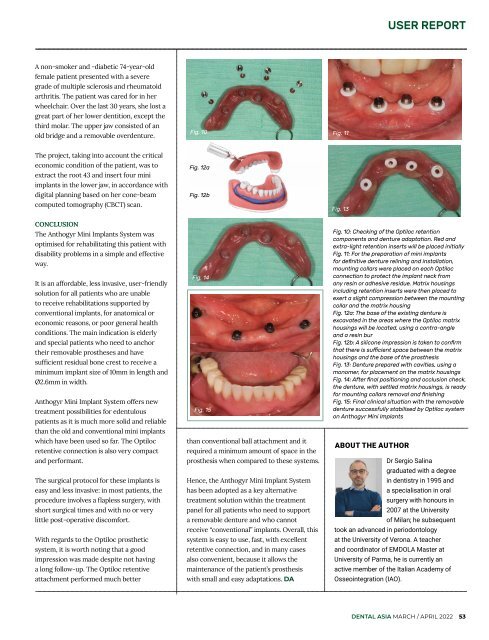Dental Asia March/April 2022
For more than two decades, Dental Asia is the premium journal in linking dental innovators and manufacturers to its rightful audience. We devote ourselves in showcasing the latest dental technology and share evidence-based clinical philosophies to serve as an educational platform to dental professionals. Our combined portfolio of print and digital media also allows us to reach a wider market and secure our position as the leading dental media in the Asia Pacific region while facilitating global interactions among our readers.
For more than two decades, Dental Asia is the premium journal in linking dental innovators and manufacturers to its rightful audience. We devote ourselves in showcasing the latest dental technology and share evidence-based clinical philosophies to serve as an educational platform to dental professionals. Our combined portfolio of print and digital media also allows us to reach a wider market and secure our position as the leading dental media in the Asia Pacific region while facilitating global interactions among our readers.
- No tags were found...
Create successful ePaper yourself
Turn your PDF publications into a flip-book with our unique Google optimized e-Paper software.
USER REPORT<br />
A non-smoker and -diabetic 74-year-old<br />
female patient presented with a severe<br />
grade of multiple sclerosis and rheumatoid<br />
arthritis. The patient was cared for in her<br />
wheelchair. Over the last 30 years, she lost a<br />
great part of her lower dentition, except the<br />
third molar. The upper jaw consisted of an<br />
old bridge and a removable overdenture.<br />
Fig. 10 Fig. 11<br />
The project, taking into account the critical<br />
economic condition of the patient, was to<br />
extract the root 43 and insert four mini<br />
implants in the lower jaw, in accordance with<br />
digital planning based on her cone-beam<br />
computed tomography (CBCT) scan.<br />
CONCLUSION<br />
The Anthogyr Mini Implants System was<br />
optimised for rehabilitating this patient with<br />
disability problems in a simple and effective<br />
way.<br />
It is an affordable, less invasive, user-friendly<br />
solution for all patients who are unable<br />
to receive rehabilitations supported by<br />
conventional implants, for anatomical or<br />
economic reasons, or poor general health<br />
conditions. The main indication is elderly<br />
and special patients who need to anchor<br />
their removable prostheses and have<br />
sufficient residual bone crest to receive a<br />
minimum implant size of 10mm in length and<br />
Ø2.6mm in width.<br />
Anthogyr Mini Implant System offers new<br />
treatment possibilities for edentulous<br />
patients as it is much more solid and reliable<br />
than the old and conventional mini implants<br />
which have been used so far. The Optiloc<br />
retentive connection is also very compact<br />
and performant.<br />
The surgical protocol for these implants is<br />
easy and less invasive: in most patients, the<br />
procedure involves a flapless surgery, with<br />
short surgical times and with no or very<br />
little post-operative discomfort.<br />
With regards to the Optiloc prosthetic<br />
system, it is worth noting that a good<br />
impression was made despite not having<br />
a long follow-up. The Optiloc retentive<br />
attachment performed much better<br />
Fig. 12a<br />
Fig. 12b<br />
Fig. 14<br />
Fig. 15<br />
than conventional ball attachment and it<br />
required a minimum amount of space in the<br />
prosthesis when compared to these systems.<br />
Hence, the Anthogyr Mini Implant System<br />
has been adopted as a key alternative<br />
treatment solution within the treatment<br />
panel for all patients who need to support<br />
a removable denture and who cannot<br />
receive “conventional” implants. Overall, this<br />
system is easy to use, fast, with excellent<br />
retentive connection, and in many cases<br />
also convenient, because it allows the<br />
maintenance of the patient’s prosthesis<br />
with small and easy adaptations. DA<br />
Fig. 13<br />
Fig. 10: Checking of the Optiloc retention<br />
components and denture adaptation. Red and<br />
extra-light retention inserts will be placed initially<br />
Fig. 11: For the preparation of mini implants<br />
for definitive denture relining and installation,<br />
mounting collars were placed on each Optiloc<br />
connection to protect the implant neck from<br />
any resin or adhesive residue. Matrix housings<br />
including retention inserts were then placed to<br />
exert a slight compression between the mounting<br />
collar and the matrix housing<br />
Fig. 12a: The base of the existing denture is<br />
excavated in the areas where the Optiloc matrix<br />
housings will be located, using a contra-angle<br />
and a resin bur<br />
Fig. 12b: A silicone impression is taken to confirm<br />
that there is sufficient space between the matrix<br />
housings and the base of the prosthesis<br />
Fig. 13: Denture prepared with cavities, using a<br />
Fig. 15<br />
monomer, for placement on the matrix housings<br />
Fig. 14: After final positioning and occlusion check,<br />
the denture, with settled matrix housings, is ready<br />
for mounting collars removal and finishing<br />
Fig. 15: Final clinical situation with the removable<br />
denture successfully stabilised by Optiloc system<br />
on Anthogyr Mini Implants<br />
ABOUT THE AUTHOR<br />
Dr Sergio Salina<br />
graduated with a degree<br />
in dentistry in 1995 and<br />
a specialisation in oral<br />
surgery with honours in<br />
2007 at the University<br />
of Milan; he subsequent<br />
took an advanced in periodontology<br />
at the University of Verona. A teacher<br />
and coordinator of EMDOLA Master at<br />
University of Parma, he is currently an<br />
active member of the Italian Academy of<br />
Osseointegration (IAO).<br />
DENTAL ASIA MARCH / APRIL <strong>2022</strong> 53


















